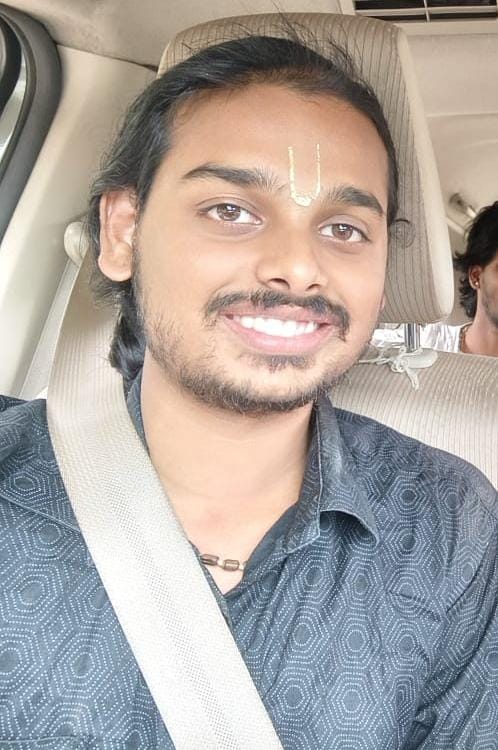Santhanaraman – Aparna Sridhar Interview
Shri R Sriganesh (Santhanaraman) of Shrimad Valmiki Ashrama is a dedicated and disciplined student of the Vedas, currently pursuing a B.A in Vedanta. He is committed to preserving and propagating the knowledge of Sanatana Dharma through rigorous scriptural studies and traditional oral transmissions
Under the guidance of Dr. Ranganji, he is focusing on deep Vedic philosophy and scriptural studies such as Veda bhashyas, Ramayana , Bhagavad Gita etc.
He did his schooling at
Thiruvidaimarudur Shankara Matam and received foundational education in Vedic chanting and Sanskrit learning.
He has successfully appeared for Sama Veda examinations at reputed Vedic centers-
Kanchipuram, Sringeri, Mysore, Thiruvannamalai, Mannargudi, and Kumbakonam and is
Proficient in Sama Veda recitation rooted in traditional gurukula-style learning.
In this interview he talks about the connections between Samaveda and Sangeetha.
Do you think Shastriya Sangeeth can regain some of the meditative or spiritual grounding found in Samagaana?
How do these traditions reflect the Indian approach of blending art, science, and spirituality?
In your view, what is the spiritual or meditative dimension of Swara Samagaana compared to concert-oriented Shastriya Sangeeth?
Spirituality in Samaveda is set to calm our mind and to be one with our own self.
साम सान्त्वप्रयोगे this is the route word of Sama. As Ramanuja says, “Surrendering leads to expansion,” Sastriya Sangeetam is filled with devotion towards the Divine. Through singing, Sangeetha Vidwans like Thyagaraja surrendered themselves to the Divine.
How do the tonal systems (swarasthanas) in Samagaana relate to the shruti and raga frameworks of classical music?
Swarasthanas here in Samaveda start from madhyama to panchama. Prathama dwitiya tritiya chaturtha. Swaras(Vaideeka) predominantly have madhyama gandhara rishaba and shadja.
And three swaras Chathurtha Mandra atiswaria has daivata nishada and panchama.
ChaturShruti rishabha Sadharanagandhara Suddha madhyama Kaisika Nishad ChatuShruti Daivata these are all the swaras used in Sama. So, we can say that the Raga of Sama is Khara Hara Priya.
What role do intonation and precision of swaras play in Samagaana versus in modern classical renditions?
Sama gana traditions now have the book to do Adyayana. But, by only having the Samaveda text one can’t learn it himself and can’t chant it properly. One has to follow the Gurukula system to learn sama.
So the book is only a tool for Samavedins. Oral learning is more important than using a book to do Adyayana.
How is tala (rhythm) treated in Samagaana, given that it is often more free-flowing than in structured kriti or raag performance?
The differences are In shastriya Sangeetha – one should have creativity. For example, in Sangeeta tradition Kalpana swara is there.
But on the other hand, samavedins have creativity only in Yajgya. Some Sama they sing in Yajgya would not come under the scope of what they learnt in Gurukula. So they have to use their creativity there. But they are allowed to use it only there, not anywhere else.
How are Samagaana traditions being preserved today? Are they still transmitted through oral parampara like the Vedas?
Sama gana traditions now have the book to do Adyayana. But, by only having the Samaveda text one can’t learn it himself and can’t chant it properly. And has to follow the Gurukula system to learn sama.
So, the book is only a tool for Samavedins. Oral learning is more important than using a book to do Adyayana.
How does training for a Samagaana practitioner differ from a Shastriya Sangeeth student?
The differences are that in shastriya Sangeetha, one should have creativity. For example, in Sangeeta tradition, Kalpana swara is there.
On the other hand, samavedins have creativity only in Yajgyas. Some Sama they sing in Yajgya would not come under the scope of what they learned in Gurukula. So they have to use their creativity there. But, they are allowed to use it only there, not anywhere else.
Are there challenges in getting younger generations interested in Samagaana, given its ritual and non-concert nature?
To give the Sama vidya to the next generation, we should educate them about the importance of enjoying the resonance in our body which is created by Sama(also Sangeeta has this resonance within it) and training them in the calmness.
Many believe Samagaana is more than music—it’s a form of yajna or spiritual practice. How do you see its role beyond sound?
Understanding Sama as merely music is not a fault. But, Sama has it’s own sahitya which is nothing but the Rikhs. One should understand the meaning of the Rikhs and recite Sama. This is how the Veda expects us to perform it (comes in Bramhana baga of Samaveda).
Do you think Sastriya Sangeetam can regain some of the meditative or spiritual grounding found in Samagaana?
I have given answers about the resonance. It plays a major role in spirituality. By reciting Sama, one can easily plunge into his own consciousness. This happens because he cleanses his thoughts, psychic modes and imprints by reciting the Rikhs as Sama. This is the intention of the veda. The veda wants us to clean our imprints . Without cleaning our imprints, reading the veda is in vain. The veda itself says this – “यस्तन्न वेद किमृचा करिष्यति.”

